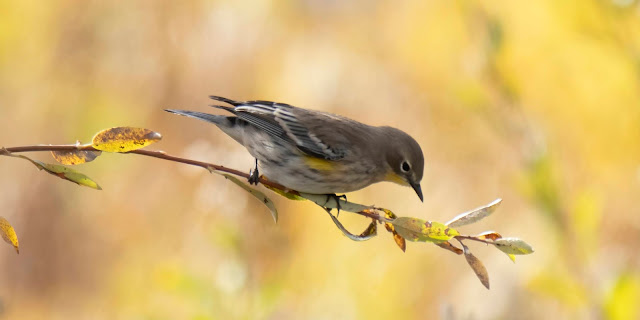 |
| Our quarry: a Wild Horse |
We stopped at a lovely park near the southern segment of the National Elk Preserve, but I cannot recall the park's name or find it on a map. Anyway, it had access to the Snake River ...
 |
| Snake River; Photo: Scott Stevens Great fall foliage ... |
 |
| In the week and a half we had been gone, fall had come on strong |
And, some adorable Yellow-rumped Warblers ...
 |
| Yellow-rumped Warbler against an autumnal backdrop |
 |
| Bridge over the Snake River; Photo: Scott Stevens And to view a kayak run ... |
 |
| Wild River |
We explored a bit and headed on, arriving in Rock Springs in the late afternoon.
Wild Horses
Our goal was the 24-mile-long self-guided Pilot Butte Wild Horse Scenic Loop that travels between Rock Springs and Fourteen-Mile Hill near Green River.
 |
| Wild Horses |
Located on top of White Mountain, 7,949-feet-tall Pilot Butte was named by early travelers in the region because it served as a signal that they were close to the Green River. And, looking at the landscape, you can appreciate how much proximity to water would mean.
We drove part of the gravel road the afternoon we arrived and got nothing for it except a flat tire (apparently the sharp rocks cause a lot of flat tires, according to the tire shop that fixed it).
 |
| Scott hard at work |
With brand new tires, we set out the next morning and finally encountered seven of the allegedly 1,500 - 2,500 Wild Horses that live on the Mountain and are a subset of the approximately 6,000 Wild Horses that live in Wyoming.
 |
| Youngster with an interesting blaze |
Whether Wild Horses are native depends on how you look at it.
Horses first roamed the grasslands of North America during the Pleistocene Epoch about 10,000 years ago.
Then, for unknown reasons, they vanished until the 1500's, when Hernando Cortez and his Spanish Conquistadors brought horses from Spain, reintroducing the species to the West. Today's herds are descendants of those Spanish steeds, mixed with ranch horses that were turned out or escaped.
Then, for unknown reasons, they vanished until the 1500's, when Hernando Cortez and his Spanish Conquistadors brought horses from Spain, reintroducing the species to the West. Today's herds are descendants of those Spanish steeds, mixed with ranch horses that were turned out or escaped.
The bloodlines include Thoroughbred, Morgan, Standard Breed, Arabian, Bashkir Curly, Pinto, Appaloosa, Quarter and several work horse breeds, maybe even a little Clydesdale.
 |
| I am not an expert, so I can't pinpoint breeds; Photo: Scott Stevens |
 |
| To me, this Horse in Bighorn Canyon, Montana, looks wilder; 2016 |
 |
| A real beauty |
Wild horses have no natural predators other than an occasional Mountain Lion, which can result in overpopulation, especially since the population can increase as much as 40 percent in a good year. The Pilot Butte herd is managed by the BLM, which conducts a periodic census and culls the herd to prevent overgrazing and death from starvation, dehydration and the elements. of course, culling Wild Horses is controversial. I would prefer more natural predators.
 |
| Three of the seven |
The horses were a bit skittish, but did stick around long enough to be photographed.
 |
| This one seemed more interested than the others |
It was a quick stop, but a nice ending to a great trip.
Trip date: September 29-October 4, 2020
No comments:
Post a Comment